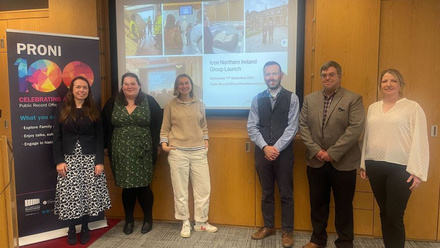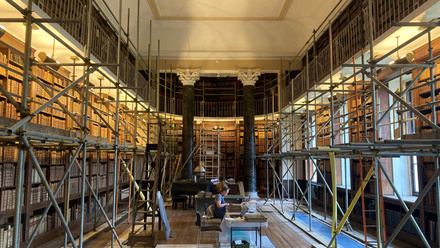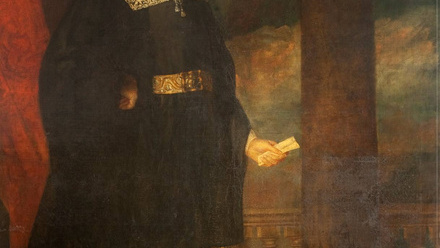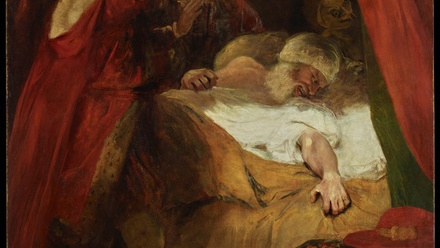Hundreds of dedicated professionals work in a wide network of conservation studios dotted across the UK and beyond to care for the items that matter most to you - everything from national treasures to family heirlooms and collectables. The conservators working in these specialist studios don’t just make things look good. Conservators take the time to understand the objects they work on and use their professional knowledge to suggest the most appropriate treatment methods to protect your precious objects. And you can find them through our Conservation Register.
Our second post in the series looks at the conservation of medieval wall paintings in a Grade 1 listed church in Stoke Orchard, showing us how The REAL Repair Shop is not a cosy old barn nestled deep in the British countryside but can be found anywhere - as in this case a church!
Conservation of wall paintings at St James the Great in Stoke Orchard, England
It was the feeling of pride to be custodians in our lifetime, that led us to...find a way forward.
The client: The Parochial Church Council of Tredington and Stoke Orchard supported by the Gloucester Diocesan Advisory Committee
Roger Grimshaw (PCC):
The Parish of Stoke Orchard and Tredington is set in a rural area of Gloucestershire between the towns of Tewkesbury and Cheltenham, and the City of Gloucester. It consists of two communities, Tredington (pop approx. 180) and Stoke Orchard (pop approx. 800). We have two medieval churches under our care, St John’s in Tredington and St James’ in Stoke Orchard, where our relatively small congregations meet on alternative weeks for worship. As a community we are very proud of our churches despite the financial pressures involved in looking after two highly listed buildings. As a PCC, we have recognised that a positive attitude will find a solution.
It was this attitude that brought us to search for a way forward for the future of our ancient Grade I listed church of St James the Great in Stoke Orchard (circa 1160). The remarkable aspect of this small church are the extensive wall paintings in the nave depicting the life of St James the Great and later schemes in a fragmentary state, which needed conservation attention. It was the feeling of pride to be custodians in our lifetime, that led us to meet with the Gloucester DAC in March 2019 and find a way forward.
Following initial surveys, consultations with external heritage bodies and obtaining necessary permissions, in just over six months, and with much help of the Diocesan Secretary, Adam Klups, we have raised in excess of £85,000 in grants. The Perry Lithgow Partnership were appointed as our conservators both to carry out the condition survey and to lead on the treatment.
It is our hope that we can now forge a partnership with a specialist College/University course to carry forward educational activities and design better interpretation of the paintings and, dare I say, address other important things on our ‘to do’ list including seating, lighting and heating!
The message we would like to share through this piece is of positive co-operation between the parish, the diocese, our conservators and other partners, mixed with a ‘can do’ attitude. It was my privilege to represent our parish and lead on this project.
Conservation in the ecclesiastical context can benefit individual congregations by enabling them to appreciate, study and cherish the heritage they are custodians of even more.
Adam Klups (DAC and Icon trustee):
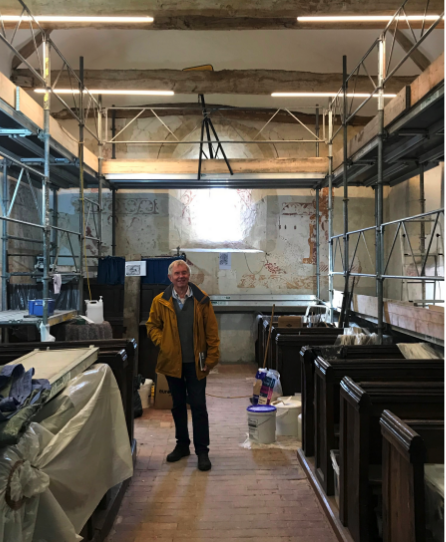
The Stoke Orchard Wall Paintings Conservation Project was a collaborative effort, which would not have happened without many individuals and organisations.
PCCs, who look after some of the most significant churches and their collections across the country, are volunteers with modest budgets and no regular income or central funding. In order to fund conservation projects like this one, a significant injection of funds from grant making bodies and individual supporters is required and relevant consents secured. The process may seem daunting, yet it can also be exciting!
The PCC of Tredington and Stoke Orchard, who recognised the uniqueness of the wall paintings at St James’ church, were extremely brave to commit to this project. Advised by the Gloucester DAC, they agreed that they wished the conservation treatment to be carried out by an experienced team led by accredited conservators. This has become one of the requirements of the competitive tendering process, which we carried out.
Although the conservation treatment was undoubtedly the most tangible of the project’s aims, the project group were keen to ensure that it delivered other important objectives. These included an ambition to create training opportunities for young people entering the conservation profession. The clients and conservators agreed that two positions would be created: one for a conservation intern, lasting 2 weeks and one for a conservation graduate, for a period of 8 weeks.
Another ambition of ours was to ensure that the project could excite and inspire the local community, as well as others across Gloucestershire and beyond. The project group recognised that telling the story of our conservation ‘adventure’ and communicating what we have achieved, can help those who may wish to embark on similar projects and get more involved with the heritage, and activities of their local church.
Conservation in the ecclesiastical context can benefit individual congregations by enabling them to appreciate, study and cherish the heritage they are custodians of even more. The enthusiasm of the PCC and the local community in Stoke Orchard for this important conservation project, and the willingness of our conservation team to ensure that the project fulfils its various objectives and ambitions were truly inspirational.
We were also able to provide an opportunity for two emerging conservators to gain first-hand experience of working in the field, alongside accredited conservators.
The conservator: Perry Lithgow Partnership
Mark Perry, ACR:
As conservators we were delighted to be given the opportunity to work on one of the most important and complete medieval schemes of wall painting surviving in this country. The project has run very smoothly and efficiently, due in large part to our close working relationship with the client (the PCC) and the DAC. We have found that communication is a very important part of any conservation project and this has certainly been true at Stoke Orchard, where explaining to the client what we do as conservators and why, including managing expectations, is vital to a successful outcome for all concerned. The rigorous process of accreditation provides us with the tools to be able to achieve this.
Icon Accreditation is a recognition of high standards in both practical work and an ethical approach to conservation. In our company, both Richard and myself are accredited. With several grant-funding bodies now insisting on this qualification as a prerequisite, we consider this a major advantage and potential attraction to clients. As an assurance to the client, we have at least one of us on site at all times, which ensures consistency in approach and execution. On many projects we are also able to attract similarly qualified and very experienced conservators to become part of the team. At Stoke Orchard, the inclusion in the team of Claudia Fiochetti ACR, one of our regular associates, significantly raised the quality of the remedial treatments being carried out.
The requirements of the Stoke Orchard project meant that we were also able to provide an opportunity for two emerging conservators to gain first-hand experience of working in the field, alongside accredited conservators. It is hoped that this experience will encourage them to pursue conservation as a full-time future career and Icon accreditation as an aim.
Watch a video of the conservation project here.
Banner image: Mark Perry during grouting. Credit: Perry Lithgow Partnership.


